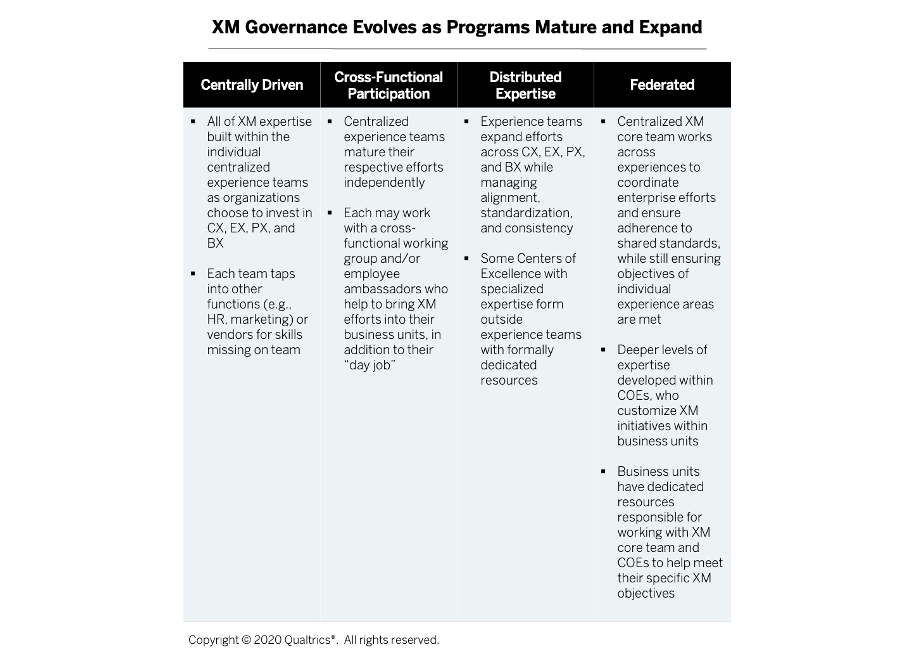One of the key skills associated with leading experience management (XM) is program governance. When XM is truly successful, it touches the entire organization. That’s why you need a governance structure to catalyze and manage the transformation. Often these structures form within individual experience areas — customer, employee, product, brand. Yet as organizations raise their XM maturity and expand their efforts across experience areas, it requires the approach to governance to change as well. What might those changes look like? We first explored this topic in the research report The Federated Customer Experience Model, and it’s worth relooking at the evolution of governance through the more complete lens of XM.
Three Components of a Federated XM Governance Model
Many times XM programs — whether customer (CX), employee (EX), product (PX), or brand (BX) — initially organize themselves by creating a centralized team to develop and implement relevant best practices across the organization. Centralized teams can be efficient at developing internal capabilities and influencing change, but oftentimes their limited scope and reach can result in ongoing struggles to embed ongoing, sustainable practices, and behaviors. Because of this, we continue to see organizations shift to a federated XM model that better enables coordinating a distributed set of capabilities and tailoring best practices to individual parts of the business. The evolution from a centralized to federated approach is built upon three components:
- Centers of Excellence. As organizations move away from centralized teams, Centers of Excellence (COEs) emerge to build and maintain a specialized set of capabilities. COE members support the rest of the organization with their expertise and skills.
- Enterprise Coordination. Even as governance becomes distributed, there is still a need for a smaller core team to coordinate critical activities to prevent localized deviation where it’s most important. It oversees the setting of collective goals, enforces enterprise-wide standards of methodologies or tools, and cross-pollinates ideas and successful practices.
- Distributed Skills and Mindsets. Successful XM transformations only happen when everyone in the organization understands how they make the desired experience a reality. COEs do not replace the need to infuse XM-centric mindsets and skills across the company.
The Path to Federation
These components become more developed and prominent as the governance model evolves from Centrally Driven to Federated across four phases:
- Centrally Driven. As XM efforts in a single experience area get underway, centralized teams have control over experience-specific management efforts across the entire organization. In this model, this team focuses on building strong internal capabilities in their specific experience domain to serve the company.
- Cross-Functional Participation. An organization can begin to experiment with federation by enabling business units to begin to do some XM work on their own in a single experience area by introducing either a cross-functional working group or employee ambassadors drawn from across different teams. In this model, a centralized team manages the organization’s XM efforts in an experience area and works with the working group or ambassadors on specific initiatives, who serve as liaisons with the business units they represent.
- Distributed Expertise. As an organization moves further down the path towards federation, it begins to naturally expand its focus, and by extension some of its central XM capabilities, across the different experience areas of the business. As XM expertise starts to spread, team members from CX, EX, PX, or BX identify opportunities to learn how to take their processes and practices and structure them so they can be deployed in collaboration with another core experience area. They work with each other through the learning curve of successfully adopting XM practices as XM expansion takes hold.
- Federated. When a company is fully federated, a new version of the centralized XM core team works across experience domains and coordinates enterprise-wide XM priorities and standard methodologies. The XM core team may still have representatives specializing in individual experience areas, who collectively work with various Centers of Excellence (COEs) to support specific initiatives and projects in business units. In a federated model, there are dedicated employees in those business units who execute specific XM plans and tap into the COEs for what they need to fulfill their responsibilities.

Aimee Lucas, CCXP, is an XM Catalyst with the Qualtrics XM Institute





